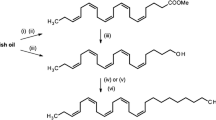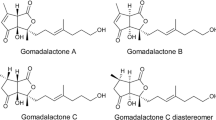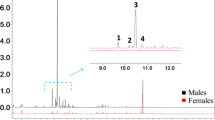Abstract
Existence of an aggregation pheromone inDrosophila hydei was demonstrated by laboratory bioassay. The pheromone was produced by mature males, but both sexes responded. The nonpolar components consisted of three esters: the methyl, ethyl, and 1-methylethyl (isopropyl) esters of 2-methyl-(E)-2 butenoic (tiglic) acid, and two ketones: 2-tridecanone and 2-pentadecanone. The ketones and esters alone were only minimally active in the laboratory bioassay, but 2-tridecanone was highly synergistic with each of the esters, mixtures attracting 3–60 times more flies than the single components. 2-Pentadecanone was less active, but it did cause significant increases in activity when added to synthetic mixtures. The nonpolar portion of an extract of mature males and an equivalent mixture of the synthetic components were not significantly different in bioassay. Neither the esters nor the ketones were detected in sexually immature males or in females of any age. In extracts of mature males, ethyl tiglate was usually the most abundant ester component, with a mean of 8 ± 5 (SD) ng/male. The absolute and relative levels of the other esters were more variable. The mean level of methyl ketones in the extracts was 122 ± 106 (SD) ng/male, of which 85–93% was 2-tridecanone.
Similar content being viewed by others
References
Bartelt, R.J., andJackson, L.L. 1984. Hydrocarbon component of theDrosophila virilis (Diptera: Drosophilidae) aggregation pheromone: (Z)-10-heneicosene.Ann. Entomol. Soc. Am. 77:364–371.
Bartelt, R.J., Jackson, L.L., andSchaner, A.M. 1985a. Ester components of the aggregation pheromone ofDrosophila virilis (Diptera: Drosophilidae).J. Chem. Ecol. 11:1197–1208.
Bartelt, R.J., Schaner, A.M., andJackson, L.L. 1985b.csi-Vaccenyl acetate as an aggregation pheromone inDrosophila melanogaster.J. Chem. Ecol. 11:1746–1756.
Blum, M.S., Jones, T.H., Overal, W.L., Fales, H.M., Schmidt, J.O., andBlum, N.A. 1983. Exocrine chemistry of the monotypic ant genusGigantiops.Comp. Biochem. Physiol. 75B:15–16.
Francke, W., Schroeder, W., Engels, E., andEngels, W. 1983. Variation in cephalic volatile substances in relation to worker age and behavior in the stingless bee,Scaptotrigona postica.Z. Naturforsch. 38C:1066–1068.
Markow, T.A. 1985. A comparative investigation of the mating system ofDrosophila hydei.Anim. Behav. 33:775–781.
Heller, S.R., andMilne, G.W.A. 1978. EPA/NIH mass spectral data base. Natl. Standard Reference Data Sys., Natl. Bur. Standards. NSRDS-NBS 63. Department of Commerce, Washington, D.C.
Wasserman, M. 1982. Evolution of therepleta group, pp. 61–139,in M. Ashburner, H.L. Carson, and J.N. Thompson, Jr. (eds.). The Genetics and Biology ofDrosophila, Vol. 3B. Academic Press, London.
Author information
Authors and Affiliations
Rights and permissions
About this article
Cite this article
Moats, R.A., Bartelt, R.J., Jackson, L.L. et al. Ester and ketone components of aggregation pheromone ofDrosophila hydei (Diptera: Drosophilidae). J Chem Ecol 13, 451–462 (1987). https://doi.org/10.1007/BF01880092
Received:
Accepted:
Issue Date:
DOI: https://doi.org/10.1007/BF01880092




